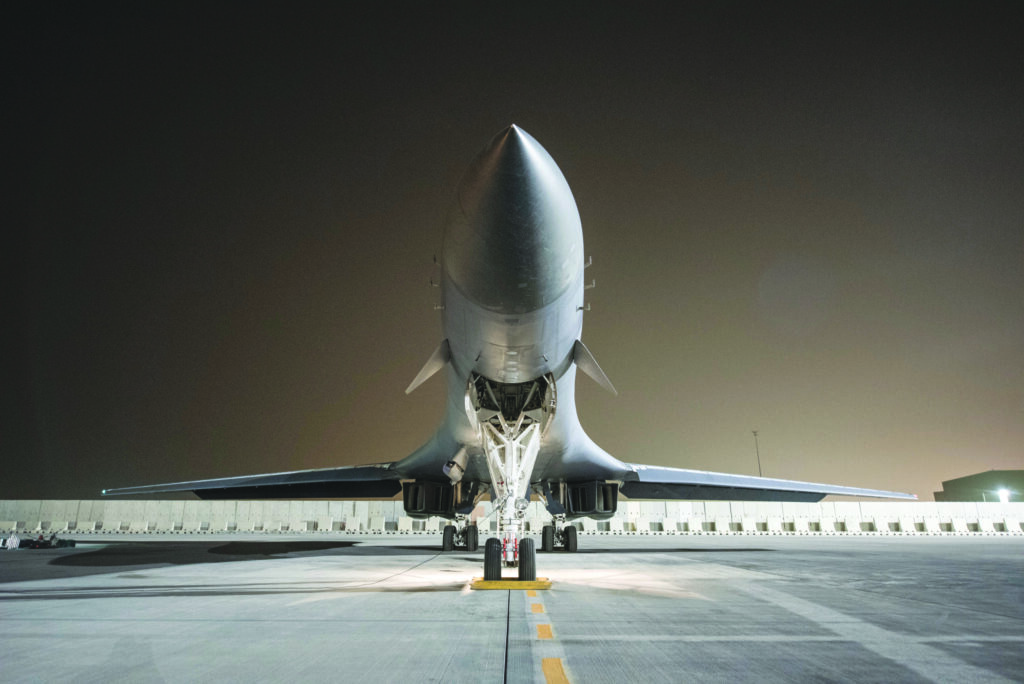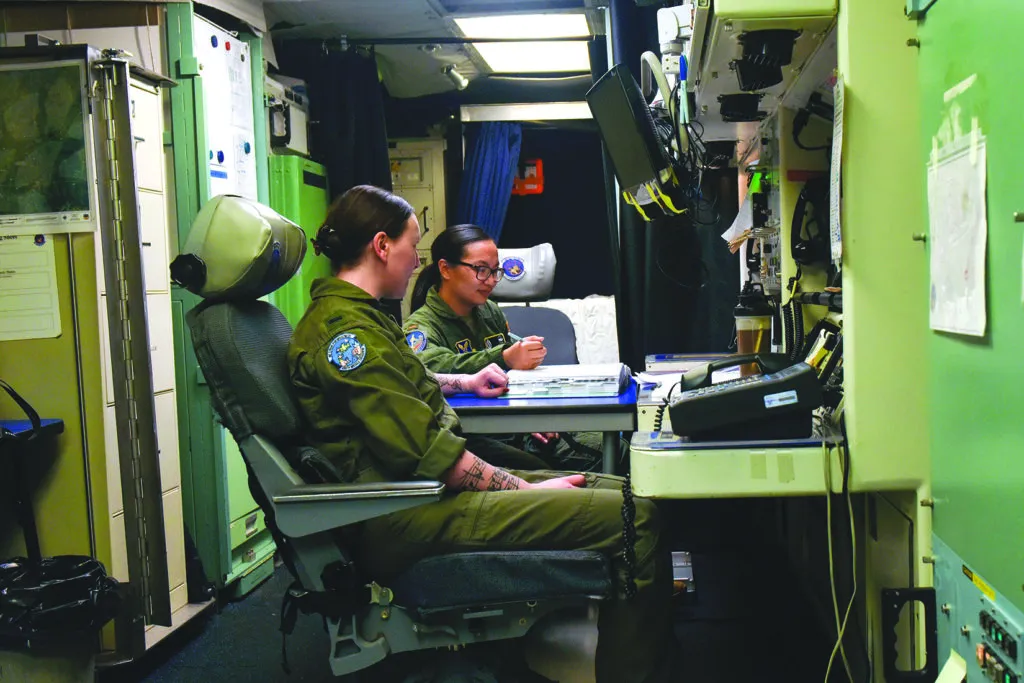The Air Force’s premier nuclear weapons program, the next-generation Sentinel intercontinental ballistic missile, is running the risk of becoming the next poster child for Pentagon procurement run amok.
When the Air Force first drew up plans for a modern replacement for its aging arsenal of more than 450 Cold War-era Minuteman III intercontinental ballistic missiles, it pegged the price at just over $62 billion. (For context, that’s roughly the same amount the Biden administration wants to give Ukraine this year in military and economic assistance.)
But, as is the case with too many major weapons programs, while it was still on the drawing board, the cost of Sentinel ICBM rose on a steady upward trajectory.
By the time Sentinel went into development in 2016, the price tag for 659 missiles was up to $85 billion, and then in 2020, it jumped to $96 billion.

A 34th Expeditionary Bomb Squadron B-1B Lancer deployed to the 379th Air Expeditionary Wing prepares to taxi in 2018, and launch a strike mission. The Air Force’s premier nuclear weapons program, The Sentinel, aims to develop state-of-the-art missiles in an ambitious 30-year plan. (Master Sgt. Phil Speck, U.S. Air Force via AP)
And just last month, the Air Force had to inform Congress the cost skyrocketed again to $131.5 billion, a whopping 37% increase, more than double the initial price tag.
That put the program in “critical breach” of a Reagan administration law aimed at curtailing massive cost overruns, triggering a review by the secretary of defense, which is often a prelude to curtailment or cancellation.
But Sentinel is not just another acquisition gone awry. It’s a key part of the Air Force’s top priority program to modernize America’s nuclear triad, which consists of submarines, bombers, and land-based missiles.
Whatever the cost overruns, Defense Secretary Lloyd Austin is expected to prevent the program’s cancellation by certifying the missile is vital to national defense and that there are no alternatives.

Two missile launch officers, or missileers, finish a 24-hour underground shift at a launch control center at Malmstrom Air Force Base in August 2023. The capsules are still very much like they were when they were first designed in the 1960s, with old gear, bad lighting and not a lot of room to move around. The capsules will be completely redesigned as part of the new Sentinel intercontinental ballistic missile system. While everything will be modernized and connected via 21st-century technology, there will still be a “human in the loop” if there was ever a launch. (U.S. Air Force via AP)
“Nothing that the department does is more important than maintaining a strong nuclear deterrent and reducing the risk of nuclear conflict,” said Air Force Maj. Gen. Pat Ryder, a Pentagon spokesman. “DOD will conduct a robust review to determine what caused the cost growth and the way ahead for the program.”
If the new state-of-the-art missile were the only upgrade needed for the land-based leg of the triad, it would be easier to justify. But the missile is just one part of a much more ambitious 30-year modernization plan that reaches $2 trillion.
The latest Sentinel cost estimate, for instance, doesn’t include the revamped W87-1 warhead, an Energy Department program estimated to cost $12 billion.
There’s also the untold cost of building new or refurbishing old silos, overhauling command-and-control facilities, not to mention the mammoth task of connecting everything with a vast new fiber-optic underground cable network spanning five states — Colorado, Montana, Nebraska, North Dakota, and Wyoming.
“We don’t know if today’s cost estimate includes building new silos. We don’t know if it includes the launch control facilities, the military alert facilities, the weapons storage facilities, the transporter-erectors that carry the missiles to the new facilities,” Sharon Weiner, visiting researcher at Princeton’s Program on Science and Global Security, said at a recent forum sponsored by the Arms Control Association.
What started out as a modest upgrade to the Minuteman III has morphed into what the Air Force calls its “largest, most complex program” ever, and with complexity comes inevitable delays and cost overruns.
“Sentinel is behind schedule due to staffing shortfalls, delays with clearance processing, and classified information technology infrastructure challenges,” a Government Accountability Office report released last summer concluded.
“Sentinel is a software-intensive program with a compressed schedule,” the report said, which puts it “high risk due to its scale and complexity and unique requirements of the nuclear deterrence mission.”
“Sentinel’s large program scope — development of new technologies, modification of existing systems, upgrades to property, establishment of new infrastructure — combined with its size — hundreds of facilities and operations that extend across the nation — further adds to its complexity.”
The Sentinel program’s mounting cost has reignited the debate in the arms control community about why submarines and bombers aren’t good enough to provide deterrence in a time of tight budgets.
“In an ideal world, would you like to have it all? Sure. All right. But what if you have to make choices in terms of the budget?” Rep. Adam Smith (D-WA) said at a congressional hearing on recommendations of the Strategic Posture Commission.
“The commission really didn’t look at it and say, ‘Gosh, you know, for $100 billion less, we could do this, we’d meet our needs, and that would really free up money elsewhere,’” Smith said. “The ground-based system, that is a heck of a lot of money to stick things in a fixed place in the ground that are incredibly vulnerable and have all manner of different problems.”
In theory, land-based missiles are easy to target because possible adversaries — which, realistically, at the moment is only Russia — would have to exhaust their arsenal of nuclear weapons to take out more than 400 U.S. missile sites. Because each underground silo would need to be targeted with at least two nuclear weapons to ensure destruction.
“This is what is sometimes referred to as ‘sponge theory’ — the idea that those ICBMs in the middle of the United States are actually a sponge that is intentionally there to soak up Russia’s nuclear weapons in the event of an attack,” Weiner said. “The notion of sponge theory basically sets up the people in the high plain states as sacrifices to stop Russia from attacking us.”
Smith, Weiner, and other arms control advocates, including former Defense Secretary William Perry, who argue the land leg of the triad should be amputated, are in the minority.
In Congress, there remains a bipartisan consensus that land-based ICBMs are a must-have part of the nuclear triad, even though they have some significant disadvantages compared to the other two legs — they can’t be recalled like bombers, and they can’t move around and hide like submarines.
But every head of the U.S. Strategic Command who has appeared before Congress in recent years has testified that the ICBM option provides important redundant capabilities, including being the most “responsive” leg, in that they can be launched in as little as seven minutes.
CLICK HERE TO READ MORE FROM THE WASHINGTON EXAMINER
That fact alone sends chills through opponents of the land-based missiles.
With the location of silos impossible to keep secret, America’s nuclear missile fields are one big fat target, which would give any president who believes America is under nuclear attack only minutes to make a decision that could end life on Earth as we know it.
